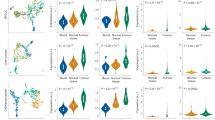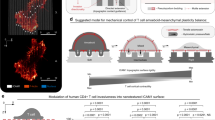Abstract
In all eukaryotes, the cell shape depends on the actin filament cytoskeleton, which is regulated by the small GTPase RhoA. It is well known that the cell shape determines cell function and behavior. Inversely, any change in the cell behavior and/or function reverberates at the cell shape. In this review, we describe how mechanical/magnetic, genetic, or pharmacologic interference with the actin cytoskeleton enforces changes in cell shape and function and how such techniques can be used to control the phenotype and functions of immune cells such as macrophages and to develop novel anti-cancer and anti-rejection clinical therapies.











Similar content being viewed by others
References
Lee M, Vasioukhin V. Cell polarity and cancer—cell and tissue polarity as a non-canonical tumor suppressor. J Cell Sci. 2008;121(Pt 8):1141–50. https://doi.org/10.1242/jcs.016634.
Geissmann F, Manz MG, Jung S, Sieweke MH, Merad M, Ley K. Development of monocytes, macrophages, and dendritic cells. Science. 2010;327(5966):656–61. https://doi.org/10.1126/science.1178331.
Kloc M, Li X, Ghobrial R. Are macrophages responsible for cancer metastasis? J Immuno Biol. 2016;1:103. https://doi.org/10.4172/jib.1000103.
Murray PJ, Wynn TA. Protective and pathogenic functions of macrophage subsets. Nat Rev Immunol. 2011;11(11):723–37. https://doi.org/10.1038/nri3073.
Kloc M, Ghobrial RM. Chronic allograft rejection: a significant hurdle to transplant success. Burns Trauma. 2014;2(1):3–10. https://doi.org/10.4103/2321-3868.121646.
Kloc M, Li X, Ghobrial RM. RhoA cytoskeletal pathway to transplantation. J Immun Clincal Res. 2014;2:1012–6.
Liu Y, Kloc M, Li XC. Macrophages as effectors of acute and chronic allograft injury. Curr Transplant Rep. 2016;3(4):303–12. https://doi.org/10.1007/s40472-016-0130-9.
Kaul AM, Goparaju S, Dvorina N, Iida S, Keslar KS, de la Motte CA, et al. Acute and chronic rejection: compartmentalization and kinetics of counterbalancing signals in cardiac transplants. Am J Transplant. 2015;15(2):333–45. https://doi.org/10.1111/ajt.13014.
Hettinger J, Richards DM, Hansson J, Barra MM, Joschko AC, Krijgsveld J, et al. Origin of monocytes and macrophages in a committed progenitor. Nat Immunol. 2013;14(8):821–30. https://doi.org/10.1038/ni.2638.
Liu Y, Minze LJ, Mumma L, Li XC, Ghobrial RM, Kloc M. Mouse macrophage polarity and ROCK1 activity depend on RhoA and non-apoptotic caspase 3. Exp Cell Res. 2016;341(2):225–36. https://doi.org/10.1016/j.yexcr.2016.02.004.
Liu Y, Tejpal N, You J, Li XC, Ghobrial RM, Kloc M. ROCK inhibition impedes macrophage polarity and functions. Cell Immunol. 2016;300:54–62. https://doi.org/10.1016/j.cellimm.2015.12.005.
Liu Y, Chen W, Minze LJ, Kubiak JZ, Li XC, Ghobrial RM, et al. Dissonant response of M0/M2 and M1 bone-marrow-derived macrophages to RhoA pathway interference. Cell Tissue Res. 2016;366:707–20. https://doi.org/10.1007/s00441-016-2491-x.
Liu Y, Kubiak JZ, Li XC, Ghobrial RM, Kloc M. Macrophages and RhoA pathway in transplanted organs. Results Probl Cell Differ. 2017;62:365–76. https://doi.org/10.1007/978-3-319-54090-0_15.
McWhorter FY, Wang T, Nguyen P, Chung T, Liu WF. Modulation of macrophage phenotype by cell shape. Proc Natl Acad Sci U S A. 2013;110(43):17253–8. https://doi.org/10.1073/pnas.1308887110.
Artemenko Y, Axiotakis L Jr, Borleis J, Iglesias PA, Devreotes PN. Chemical and mechanical stimuli act on common signal transduction and cytoskeletal networks. Proc Natl Acad Sci U S A. 2016;113(47):E7500–E9. https://doi.org/10.1073/pnas.1608767113.
Lin BH, Tsai MH, Lii CK, Wang TS. IP3 and calcium signaling involved in the reorganization of the actin cytoskeleton and cell rounding induced by cigarette smoke extract in human endothelial cells. Environ Toxicol. 2016;31(11):1293–306. https://doi.org/10.1002/tox.22133.
Cunniff B, McKenzie AJ, Heintz NH, Howe AK. AMPK activity regulates trafficking of mitochondria to the leading edge during cell migration and matrix invasion. Mol Biol Cell. 2016;27(17):2662–74. https://doi.org/10.1091/mbc.E16-05-0286.
Mehta MM, Weinberg SE, Chandel NS. Mitochondrial control of immunity: beyond ATP. Nat Rev Immunol. 2017;17(10):608–20. https://doi.org/10.1038/nri.2017.66.
Schuler MH, Lewandowska A, Caprio GD, Skillern W, Upadhyayula S, Kirchhausen T, et al. Miro1-mediated mitochondrial positioning shapes intracellular energy gradients required for cell migration. Mol Biol Cell. 2017;28(16):2159–69. https://doi.org/10.1091/mbc.E16-10-0741.
Wheeler AP, Ridley AJ. Why three Rho proteins? RhoA, RhoB, RhoC, and cell motility. Exp Cell Res. 2004;301(1):43–9. https://doi.org/10.1016/j.yexcr.2004.08.012.
Bos N, Zimmerman A, Olson J, Yew J, Yerkie J, Dahl E, et al. From shared databases to communities of practice: a taxonomy of collaboratories. J Computer-Mediated Comm. 2007;12(2):652–72. https://doi.org/10.1111/j.1083-6101.2007.00343.x.
Cherfils J, Zeghouf M. Regulation of small GTPases by GEFs, GAPs, and GDIs. Physiol Rev. 2013;93(1):269–309. https://doi.org/10.1152/physrev.00003.2012.
Dubash AD, Wennerberg K, Garcia-Mata R, Menold MM, Arthur WT, Burridge K. A novel role for Lsc/p115 RhoGEF and LARG in regulating RhoA activity downstream of adhesion to fibronectin. J Cell Sci. 2007;120(Pt 22):3989–98. https://doi.org/10.1242/jcs.003806.
Shang X, Marchioni F, Sipes N, Evelyn CR, Jerabek-Willemsen M, Duhr S, et al. Rational design of small molecule inhibitors targeting RhoA subfamily Rho GTPases. Chem Biol. 2012;19(6):699–710. https://doi.org/10.1016/j.chembiol.2012.05.009.
Shang X, Marchioni F, Evelyn CR, Sipes N, Zhou X, Seibel W, et al. Small-molecule inhibitors targeting G-protein-coupled Rho guanine nucleotide exchange factors. Proc Natl Acad Sci U S A. 2013;110(8):3155–60. https://doi.org/10.1073/pnas.1212324110.
Goode BL, Eskin JA, Wendland B. Actin and endocytosis in budding yeast. Genetics. 2015;199(2):315–58. https://doi.org/10.1534/genetics.112.145540.
Egea G, Serra-Peinado C, Gavilan MP, Rios RM. Cytoskeleton and Golgi-apparatus interactions: a two-way road of function and structure. Cell Health Cytosk. 2015:37. https://doi.org/10.2147/chc.s57108.
Marra P, Salvatore L, Mironov A Jr, Di Campli A, Di Tullio G, Trucco A, et al. The biogenesis of the Golgi ribbon: the roles of membrane input from the ER and of GM130. Mol Biol Cell. 2007;18(5):1595–608. https://doi.org/10.1091/mbc.E06-10-0886.
Maxfield FR, McGraw TE. Endocytic recycling. Nat Rev Mol Cell Biol. 2004;5(2):121–32. https://doi.org/10.1038/nrm1315.
Prosser DC, Wendland B. Conserved roles for yeast Rho1 and mammalian RhoA GTPases in clathrin-independent endocytosis. Small GTPases. 2012;3(4):229–35. https://doi.org/10.4161/sgtp.21631.
Rossanese O, Reinke C, Bevis B, Hammond A, Sears I, O'Connor J, et al. A role for actin, Cdc1p, and Myo2p in the inheritance of late Golgi elements in Saccharomyces cerevisiae. J Cell Biol. 2001;153(1):47–62.
Zilberman Y, Alieva NO, Miserey-Lenkei S, Lichtenstein A, Kam Z, Sabanay H, et al. Involvement of the Rho-mDia1 pathway in the regulation of Golgi complex architecture and dynamics. Mol Biol Cell. 2011;22(16):2900–11. https://doi.org/10.1091/mbc.E11-01-0007.
Meunier FA, Gutierrez LM. Captivating new roles of F-actin cortex in exocytosis and bulk endocytosis in neurosecretory cells. Trends Neurosci. 2016;39(9):605–13. https://doi.org/10.1016/j.tins.2016.07.003.
Mori TTK, Naito M, Kodama T, Hakamata H, Sakai M, Miyazaki A, et al. Endocytic pathway of scavenger receptors via trans-Golgi system in bovine alveolar macrophages. Lab Investig. 1994;71(3):409–16.
Liu Y, Chen W, Wu C, Minze LJ, Kubiak JZ, Li XC et al. Macrophage/monocyte-specific deletion of Ras homolog gene family member A (RhoA) downregulates fractalkine receptor and inhibits chronic rejection of mouse cardiac allografts. J Heart Lung Transpl. 2016:30292–3. https://doi.org/10.1016/j.healun.2016.08.011.
Chen W, Zhao Y, Li XC, Kubiak JZ, Ghobrial RM, Kloc M. Rho-specific guanine nucleotide exchange factors (Rho-GEFs) inhibition affects macrophage phenotype and disrupts Golgi complex. Int J Biochem Cell Biol. 2017;93:12–24. https://doi.org/10.1016/j.biocel.2017.10.009.
Porat-Shliom N, Weigert R, Donaldson JG. Endosomes derived from clathrin-independent endocytosis serve as precursors for endothelial lumen formation. PLoS One. 2013;8(11):e81987. https://doi.org/10.1371/journal.pone.0081987.
Lee K, Kim EH, Oh N, Tuan NA, Bae NH, Lee SJ, et al. Contribution of actin filaments and microtubules to cell elongation and alignment depends on the grating depth of microgratings. J Nanobiotechnology. 2016;14(1):35. https://doi.org/10.1186/s12951-016-0187-8.
Lee CH, Kim YJ, Jang JH, Park JW. Modulating macrophage polarization with divalent cations in nanostructured titanium implant surfaces. Nanotechnology. 2016;27(8):085101. https://doi.org/10.1088/0957-4484/27/8/085101.
Wang T, Luu TU, Chen A, Khine M, Liu WF. Topographical modulation of macrophage phenotype by shrink-film multi-scale wrinkles. Biomater Sci. 2016;4(6):948–52. https://doi.org/10.1039/c6bm00224b.
Wosik J, Chen W, Qin K, Ghobrial RM, Kubiak JZ, Kloc M. Magnetic field changes macrophage phenotype. Biophys J. 2018;114(8):2001–13. https://doi.org/10.1016/j.bpj.2018.03.002.
ANSYS, Maxwell. http://ansoft-maxwell.narod.ru/en/Maxwell_v16_L01_Introduction.pdf. Accessed 21 May 2013.
Eguchi Y, Ueno S, Kaito C, Sekimizu K, Shiokawa K. Cleavage and survival of Xenopus embryos exposed to 8 T static magnetic fields in a rotating clinostat. Bioelectromagnetics. 2006;27(4):307–13. https://doi.org/10.1002/bem.20215.
Denegre JM, Valles JM Jr, Lin K, Jordan WB, Mowry KL. Cleavage planes in frog eggs are altered by strong magnetic fields. Proc Natl Acad Sci U S A. 1998;95(25):14729–32.
Kauffmann P, Ith A, O'Brien D, Gaude V, Boue F, Combe S, et al. Diamagnetically trapped arrays of living cells above micromagnets. Lab Chip. 2011;11(18):3153–61. https://doi.org/10.1039/c1lc20232d.
Gassner AL, Abonnenc M, Chen HX, Morandini J, Josserand J, Rossier JS, et al. Magnetic forces produced by rectangular permanent magnets in static microsystems. Lab Chip. 2009;9(16):2356–63. https://doi.org/10.1039/b901865d.
Zablotskii V, Pastor JMn, Larumbe S, Pérez-Landazábal JI, Recarte V, Gómez-Polo C et al. High-field gradient permanent micromagnets for targeted drug delivery with magnetic nanoparticles. 2010:152–157. doi:https://doi.org/10.1063/1.3530005.
Gijs MA, Lacharme F, Lehmann U. Microfluidic applications of magnetic particles for biological analysis and catalysis. Chem Rev. 2010;110(3):1518–63. https://doi.org/10.1021/cr9001929.
Ghibaudo M, Trichet L, Le Digabel J, Richert A, Hersen P, Ladoux B. Substrate topography induces a crossover from 2D to 3D behavior in fibroblast migration. Biophys J. 2009;97(1):357–68. https://doi.org/10.1016/j.bpj.2009.04.024.
Ladoux B, Nicolas A. Physically based principles of cell adhesion mechanosensitivity in tissues. Rep Prog Phys. 2012;75(11):116601. https://doi.org/10.1088/0034-4885/75/11/116601.
Bryan AK, Hecht VC, Shen W, Payer K, Grover WH, Manalis SR. Measuring single cell mass, volume, and density with dual suspended microchannel resonators. Lab Chip. 2014;14(3):569–76. https://doi.org/10.1039/c3lc51022k.
Humphrey W, Dalke A, Schulten K. VMD: visual molecular dynamics. J Mol Graph. 1996;14(1):33–8. https://doi.org/10.1016/0263-7855(96)00018-5.
Omelchenko T, Vasiliev JM, Gelfand IM, Feder HH, Bonder EM. Rho-dependent formation of epithelial “leader” cells during wound healing. Proc Natl Acad Sci U S A. 2003;100(19):10788–93. https://doi.org/10.1073/pnas.1834401100.
Gov NS. Collective cell migration patterns: follow the leader. Proc Natl Acad Sci U S A. 2007;104(41):15970–1. https://doi.org/10.1073/pnas.0708037104.
Qian A-R, Gao X, Zhang W, Li J-B, Wang Y, Di S-M, et al. Large gradient high magnetic fields affect osteoblast ultrastructure and function by disrupting collagen I or fibronectin/αβ1 integrin. PLoS One. 2013;8(1):e51036.
Chionna A, Dwikat M, Panzarini E, Tenuzzo B, Carla EC, Verri T, et al. Cell shape and plasma membrane alterations after static magnetic fields exposure. Eur J Histochem. 2003;47(4):299–308.
Winkleman A, Gudiksen KL, Ryan D, Whitesides GM, Greenfield D, Prentiss M. A magnetic trap for living cells suspended in a paramagnetic buffer. Appl Phys Lett. 2004;85(12):2411–3. https://doi.org/10.1063/1.1794372.
Shi D, Meng R, Deng W, Ding W, Zheng Q, Yuan W, et al. Effects of microgravity modeled by large gradient high magnetic field on the osteogenic initiation of human mesenchymal stem cells. Stem Cell Rev Rep. 2010;6(4):567–78.
Beaugnon E, Tournier R. Levitation of organic materials. Nature. 1991;349(6309):470.
Kuznetsov OA, Hasenstein KH. Intracellular magnetophoresis of amyloplasts and induction of root curvature. Planta. 1996;198(1):87–94.
Yamaguchi M, Tanimoto Y. Magneto-science: magnetic field effects on materials: fundamentals and applications, Springer Series in Materials Science, Volume 89 ISBN 978-3-540-37061-1 Kodansha Ltd and Springer-Verlag Berlin Heidelberg, 2006. 2006;1.
Acknowledgments
The authors gratefully acknowledge the support from the William and Ella Owens Medical Research Foundation, the William Stamps Farish Fund, and the State of Texas through the Texas Center for Superconductivity at the University of Houston.
Author information
Authors and Affiliations
Corresponding authors
Ethics declarations
Conflict of interest
The authors declare that they have no conflict of interest.
Additional information
Publisher’s note
Springer Nature remains neutral with regard to jurisdictional claims in published maps and institutional affiliations.
Rights and permissions
About this article
Cite this article
Wosik, J., Suarez-Villagran, M., Miller, J.H. et al. Macrophage phenotype bioengineered by magnetic, genetic, or pharmacologic interference. Immunol Res 67, 1–11 (2019). https://doi.org/10.1007/s12026-019-9066-3
Published:
Issue Date:
DOI: https://doi.org/10.1007/s12026-019-9066-3




